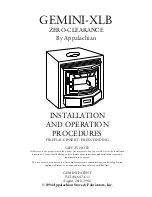
VIII. MAINTENANCE
15
There are areas of the stove and chimney system that
need periodic maintenance to ensure safe and efficient
operation.
1. ASH REMOVAL
When ashes get 3” to 4” deep in your firebox, wait until
the stove has cooled, then remove the grate at the
bottom of the heater into the ash pan below. Carefully
remove the pan. Ashes should be placed on a non-
combustible floor or on the ground, away from all
combustible materials pending final disposal. The ashes
should be retained in the closed container until all
cinders have thoroughly cooled.
NOTE: For the most efficient stove operation leave a
minimum of 2” ash in the firebox at all times. This will
help maintain a hot charcoal bed.
NOTE: DO NOT OVERFIRE THIS HEATER.
Attempts to achieve heat output rates that exceed heater
design specifications can result in permanent damage to
the heater and to the catalytic combustor.
2. CARE OF THE GLASS
The glass supplied with your stove is designed to
withstand extremely high temperatures. However, like
any glass product, IT CAN BE BROKEN! Take care not
to bump it with a log or a poker, and be sure the wood
is entirely inside the stove before attempting to close the
door.
Periodically opening the drafts and allowing the fire to
burn brightly will help reduce the soot buildup on the
glass. The glass may be cleaned with a NON-ABRASIVE
cleaner such as a spray glass cleaner or oven cleaner.
An effective way of cleaning the glass is to dip a
dampened rag in the ashes and scrub the surface clean.
The application of a non-stick cooking spray to the inner
surface of the glass will help keep it clean.
3. CHIMNEY CARE
When wood is burned slowly, it produces tar and other
organic vapors, which combine with expelled moisture
to form creosote. The creosote vapors condense in the
relatively cool chimney flue of a slow burning fire. As a
result, creosote residue accumulates on the flue lining.
The chimney connector and chimney should be
inspected at least twice yearly during the heating season
to determine if a creosote buildup has occurred.
If creosote has accumulated, it should be removed to
reduce the risk of a chimney fire.
NOTE: Insert model stoves should be removed from the
fireplace for cleaning. Slide the stove out and place it on
a piece of cardboard or drop cloths to protect the floor.
The fireplace and throat of the chimney CANNOT be
properly cleaned with the stove in place.
4. STOVE FINISH
All stoves are finished with a specially formulated high
temperature paint. During the first few firings of the
stove, a slight odor of paint may be noticed. This is
normal during the curing process and the fumes are not
hazardous. If they cause irritation, crack a window or
door for a few minutes to disperse the fumes.
NOTE: Although non-toxic, the fumes MAY set off a
smoke detector located near the stove.
5. BLOWER CARE
Remove and clean the blower every four months.
Unplug the blower before removing or servicing.
TO OIL THE BLOWER:
The blower should be oiled at least two times per season
with SAE-20. The oil ports (2) are located on the
opposite ends of the center hub on the top side of the
blower (see illustration).
6. DOOR GASKET REPLACEMENT
Remove all old gasket and clean the gasket channel, if
necessary. Put high temperature silicone adhesive in the
channel and lay the gasket in so that the ends of the
gasket meet in the bottom right corner of the door back.
Press down slightly.
7. MOTOR MAINTENANCE
Use turbine oil when lubricating motor. Perform this
task every six months.



















